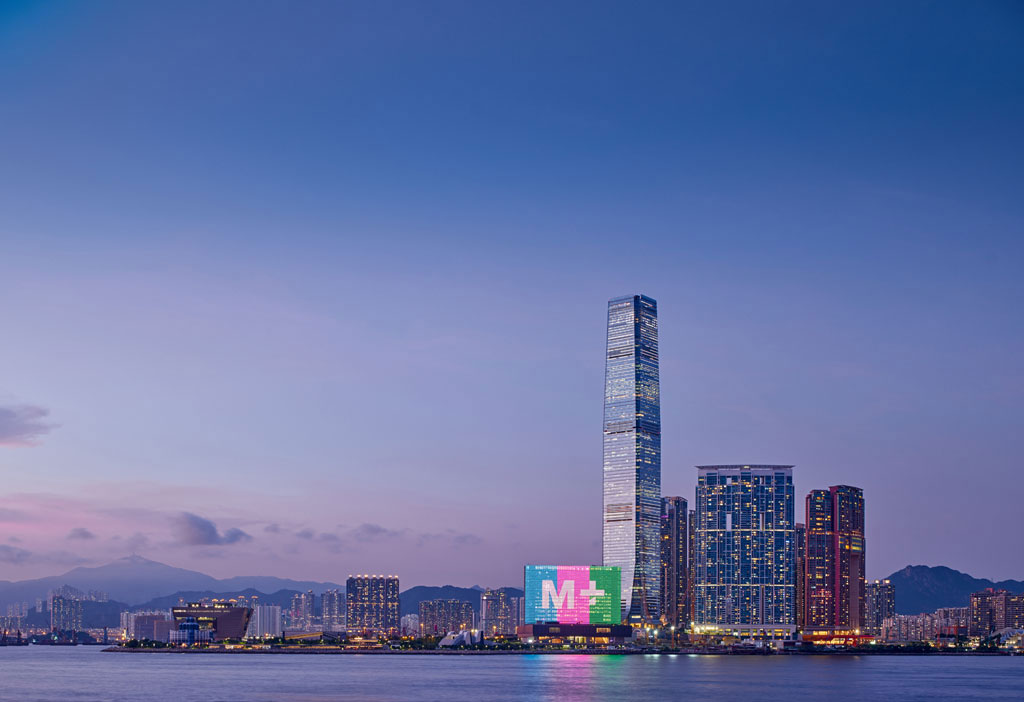Designed by Swiss architectural firm Herzog & de Meuron, Hong Kong’s global museum of visual culture M+ has 183,000 square feet of exhibition space and thirty-three galleries that display more than 6,400 works spanning modern and contemporary art. The building itself, prominent in Hong Kong’s skyline, can host artists’ work: its face is a monumental screen capable of presenting commissioned digital and video art. Inside, the donation of part of Uli Sigg’s art collection, considered one of the best collections of Chinese contemporary art, has cemented the status of the museum’s holdings.
Those who track the developments in Asia’s art scene will remember that the M+ Museum’s 2021 opening was haunted by censorship controversy after Ai Weiwei’s Study of Perspective: Tian’anmen (1997) was pulled when pro-Beijing politicians claimed the work was “spreading hatred against China” and could violate the city’s sweeping national security law. The work was arguably one of the dissident artist’s most iconic and also more critical pieces, showing Weiwei raising a middle finger at Beijing’s Tiananmen Square, where a bloody crackdown by the People’s Liberation Army on pro-democracy protesters in 1989 killed hundreds if not thousands.
But overall, the M+ Museum’s opening was ultimately successful and was followed by blockbuster shows such as the extensive Yayoi Kusama’s exhibition “Dots Obsession—Aspiring to Heaven’s Love,” which closed in January of this year. The M+ Museum also became the cornerstone of the ambitious development project that would become the West Kowloon Cultural District: a vibrant Harbour waterfront cultural quarter occupying twenty-three hectares of public open space and hosting a series of arts and entertainment venues.
After a few years, despite some aspects of the project being still in progress, the district is taking shape, with excellent pedestrian ways cutting through curated green areas dotted here and there by a series of cultural venues, which include the majestic Hong Kong Palace Museum, the Xiqu Centre, the Freespace and the Art Park, plus numerous options for drinks and dining. The much-anticipated Lyric Theatre Complex is scheduled to be completed next year.
SEE ALSO: The World Trade Center Offers Case Studies in Making Space for Artists in Urban Centers
However, a lack of funds could seriously derail the project and, ultimately, the district’s revival. Betty Fung, the chief executive of the West Kowloon Cultural District Authority (WKCDA), told the local media last summer that the Hong Kong government’s initial endowment was projected to run out by March of 2025. More concerning, the district already saw an operating deficit of HK$718 million (US$92.1 million) for the 2022-23 fiscal year, according to reporting by the South China Post. WKCDA chairman Henry Tang Ying-yen confirmed to the South China Morning Post that the group was waiting for the government to approve new funding arrangements proposed last year. If no decision is reached soon, the West Kowloon Cultural District must pause contracts for future events. “The government is actively exploring solutions,” Kevin Yeung Yun-hung, secretary for culture, sports and tourism, told Hong Kong’s The Standard last February.
Observer reached out to several local arts and culture professionals on July 1, but nobody contacted knew if this significant issue had been resolved. In mid-June, the vice-chairman of the West Kowloon District Authority, Bernard Chan, expressed optimism that an agreement would be reached but also said that some of the planned infrastructure projects might be put on hold to balance the books. But on July 1, Hong Kong’s Special Administrative Region Establishment Day holiday, there were kilometric lines at the M+ Museum, which offered free admission in celebration. The entire West Kowloon Cultural District was very crowded, showing the local appetite for what this project has successfully delivered thus far.
The uncertain state of Hong Kong’s art and culture scene
The M+ opened at a time when the Hong Kong government was allocating considerable investments to boost the city’s reputation as the central art hub in the region. But funding for the arts has been slowly stripped since then (or has become more complex to get), as some gallerists and curators told Observer. China’s growing influence and control limit the freedom of information and expression, which has led to new restrictions placed on cultural producers, who must be ever more cautious to avoid running afoul of these controls.

The current state of Hong Kong’s art and culture scene also raises questions about cultural funding and government control in what has long been a bulwark of liberal freedoms despite its closeness to China. “The West Kowloon Cultural District’s fiscal challenges reflect a systemic cultural financing issue, presenting the Hong Kong government with an occasion to recalibrate its cultural stewardship,” Gilbert Choy, director of Cloud House, wrote in a letter to the South China Morning Post. “It calls for a forward-thinking, sustainable funding model that acknowledges the intrinsic value of these institutions in rejuvenating Hong Kong’s status as a cosmopolitan hub.”
On the other hand, the West Kowloon Cultural District is also powered by substantial commercial support. In November of 2022, it awarded a 47-year tender to a subsidiary of Sun Hung Kai Properties, one of Hong Kong’s most prominent developers, to build and operate three office towers near the M+ and the Lyric Theatre Complex. The idea had always been to encourage private investment in the area, including in hospitality and business.”The West Kowloon Cultural District is designed to self-finance after some big government endowments,” WKCDA Chief Executive John Lee Ka-chiu told The Standard. Yeung Yun-hung said that the district authority will have to decide the best operating mode to optimize resources but also noted that some progress has already been made in resolving its financial issues, as the cultural hub has achieved good results and has become a popular tourist site.
When interviewed by Observer, several prominent Hong Kong residents were hopeful that an agreement would be reached, probably involving investors interested in the area. Whether that will result in opportunities to secure more independence from government control and greater freedom of content remains to be seen.

